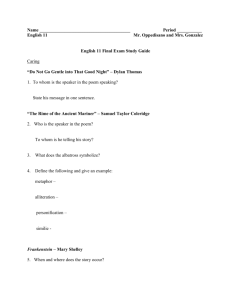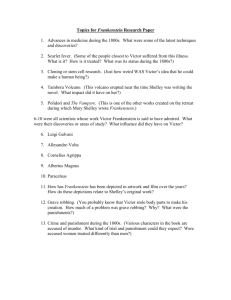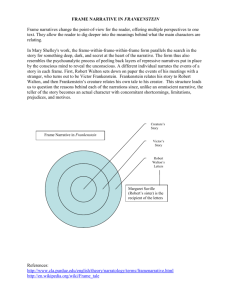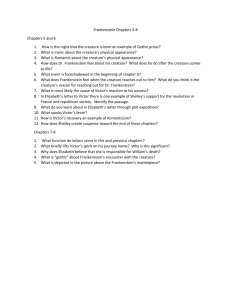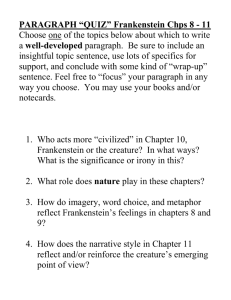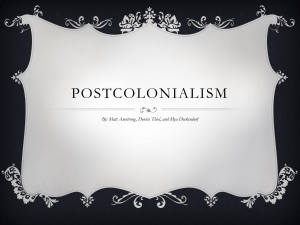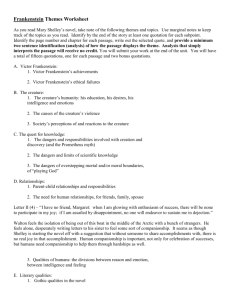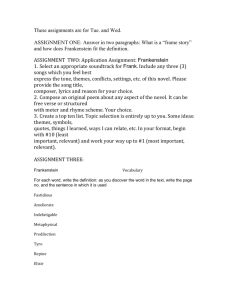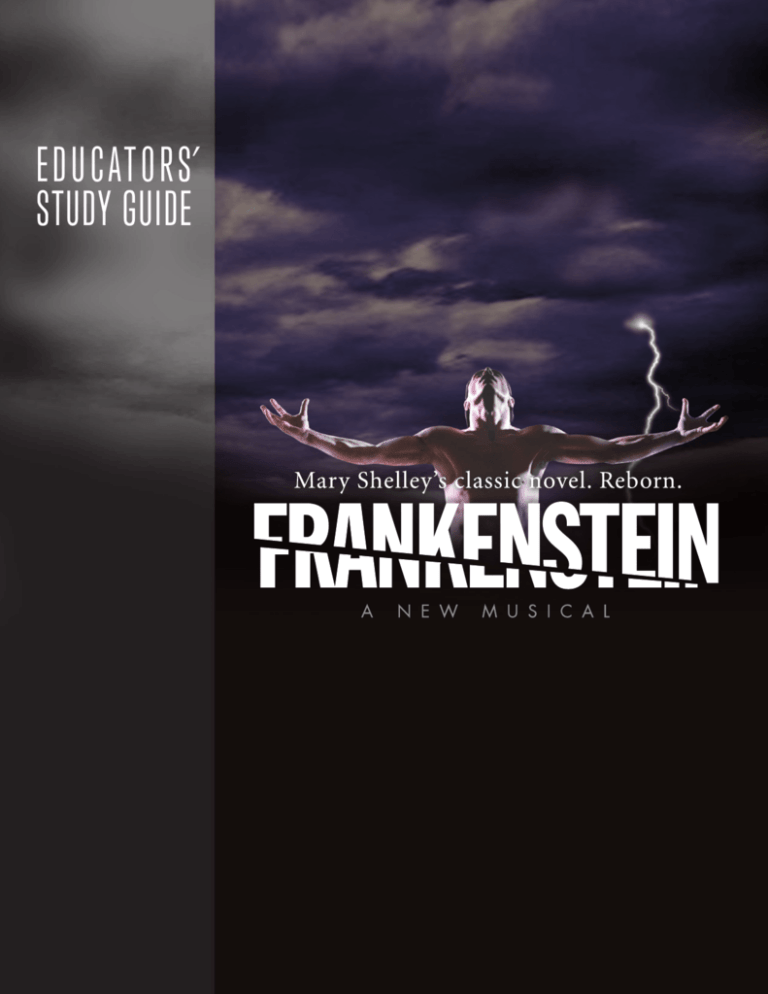
E D U C AT O R S’
STUDY GUIDE
EDUCATORS’ STUDY GUIDE
FRANKENSTEIN Educators’ Study Guide
by Patty Carver & Jeffrey Jackson
© 2007 Goehring-Evans Productions and the authors.
All rights reserved.
2
EDUCATORS’ STUDY GUIDE
3
TA B L E O F C O N T E N T S
PRE-PERFORMANCE ACTIVITIES
Mary Shelley & Frankenstein . . . . . . . . . . . . . . . . . . . . . . . . . . . . . . . . . . . . . . . . . . . . . 4
About Mary Shelley. . . . . . . . . . . . . . . . . . . . . . . . . . . . . . . . . . . . . . . . . . . . . . . . . . . . . 4
About Frankenstein . . . . . . . . . . . . . . . . . . . . . . . . . . . . . . . . . . . . . . . . . . . . . . . . . . . . . 5
The Title and Its Meaning . . . . . . . . . . . . . . . . . . . . . . . . . . . . . . . . . . . . . . . . . . . . . . . 6
Frankenstein as a Gothic Novel . . . . . . . . . . . . . . . . . . . . . . . . . . . . . . . . . . . . . . . . . . . 6
Frankenstein as Science Fiction . . . . . . . . . . . . . . . . . . . . . . . . . . . . . . . . . . . . . . . . . . . 6
Summary of Frankenstein . . . . . . . . . . . . . . . . . . . . . . . . . . . . . . . . . . . . . . . . . . . . . . . 7
The Characters in the Novel . . . . . . . . . . . . . . . . . . . . . . . . . . . . . . . . . . . . . . . . . . . . 11
Key Facts About Frankenstein . . . . . . . . . . . . . . . . . . . . . . . . . . . . . . . . . . . . . . . . . . . 12
Frankenstein on Stage, Film and TV . . . . . . . . . . . . . . . . . . . . . . . . . . . . . . . . . . . . . . 13
Creating the Stage Musical Frankenstein. . . . . . . . . . . . . . . . . . . . . . . . . . . . . . . . . . . 15
Theater Etiquette and Questions Middle-Grade Students May Ask . . . . . . . . . . . . 17
Vocabulary List and Activities . . . . . . . . . . . . . . . . . . . . . . . . . . . . . . . . . . . . . . . . . . . 18
Frankenstein Crossword Puzzle . . . . . . . . . . . . . . . . . . . . . . . . . . . . . . . . . . . . . . . . . . 19
POST-PERFORMANCE ACTIVITIES
Questions About the Performance . . . . . . . . . . . . . . . . . . . . . . . . . . . . . . . . . . . . . . . 21
Frankenstein Quiz—Fill in the Blanks . . . . . . . . . . . . . . . . . . . . . . . . . . . . . . . . . . . . 22
Discussion and Essay Questions . . . . . . . . . . . . . . . . . . . . . . . . . . . . . . . . . . . . . . . . . 23
EDUCATORS’ STUDY GUIDE
4
PRE PERFORMANCE ACTIVITIES
MARY SHELLEY & FRANKENSTEIN…
In the summer of 1816, a young, well-educated woman from England traveled
with her lover to the Swiss Alps. Unseasonable rain kept them trapped inside their
lodgings, where they entertained themselves by reading ghost stories. At the urging
of renowned poet Lord Byron, a friend and neighbor, they set their own pens to
paper, competing to see who could write the best ghost story. The young woman,
Mary Wollstonecraft Godwin, took the prize, having composed a story creepy
enough not only to take its place alongside the old German tales that she and her
Alpine companions had been reading, but also to become a bestseller in her time
and a Gothic classic that still resonates with readers almost two centuries later.
ABOUT MARY SHELLEY
Mary Wollstonecraft Godwin was born on August
30, 1797 in London. Her mother, Mary
Wollstonecraft, wrote The Vindication of the Rights of
Women, a feminist tract that encouraged women to
think and act for themselves. Wollstonecraft died
giving birth to Mary, leaving her daughter in the care
of her husband, William Godwin, a member of the
radical thinkers of England including Thomas Paine
and William Blake. This literary background afforded
Mary exposure to the most cutting edge and radical
ideas of the day.
As a teenager, Mary met and fell in love with the then married poet, Percy
Bysshe Shelley. Their affair lasted for two years and they were married under
scandalous circumstances; Harriet, Percy’s wife and pregnant with his child,
drowned herself in London. Mary and Percy were married a few weeks later.
Percy edited the manuscript for Frankenstein and is commonly believed to have
written the preface under her name. Frankenstein was published on January 1st,
1818 and became an immediate best seller. From 1815 to 1819 Mary and Percy
had four children. Three of the four died in infancy. In 1822 Percy drowned off
the shore of Tuscany, leaving Mary a widow and single mother. She devoted the
rest of her life to her own writing and publishing her husband’s works. Mary
Shelley, plagued with serious illness, died in London in February, 1851.
EDUCATORS’ STUDY GUIDE
5
ABOUT FRANKENSTEIN
The early nineteenth century was not a good time
to be a female writer, particularly if one was
audacious enough to be a female novelist.
Contemporary “wisdom” held that no one would be
willing to read the work of a woman; the fantastic
success of Mary Shelley’s Frankenstein served to
thoroughly disprove this rather foolish theory.
Frankenstein established Shelley as a woman of
letters when such a thing was believed to be a
contradiction in terms; her reputation in Europe
was surpassed only by that of Madame de Stael. De
Stael, however, was more famous for continuing to
publish her works despite the fact that the Emperor
Napoleon had explicitly forbade her to do so rather
than for the quality of the works themselves.
A page from Mary Shelley’s
original manuscript of
Frankenstein
Though it is now customarily classified as a horror story (albeit the first and
purest of its kind), it is interesting to note that Mary Shelley’s contemporaries
regarded it as a serious novel of ideas. It served as an illustration of many of the
tenets of William Godwin’s philosophy, and did more to promote his ideas than his
own work ever did. The novel does not, however, subscribe to all of Godwin’s
precepts. It stands in explicit opposition to the idea that man can achieve
perfection; in fact, it argues that any attempt to attain perfection will ultimately
end in ruin.
Frankenstein is part of the Gothic movement in literature, a form that was only
just becoming popular in England at the time of its publication. The Gothic mode
was a reaction against the humanistic, rationalist literature of The Age of Reason;
one might say it was ushered in by the death of Keats, the English author with
whom Romanticism is perhaps most closely associated. Frankenstein might be seen
as a compromise between the Gothic approach and the Romantic one: it addresses
serious philosophical subjects in a fantastical manner and though it confronts
recognizable human problems, it can hardly be said to take place in a “rational,”
comprehensible, recognizable natural world. Some critics have suggested that this
tension between Gothic and Romantic literary modes echoes the philosophical
tension that existed between Mary Shelley and her husband, the Romantic poet
Percy Bysshe Shelley.
As the prejudice against women writers was quite strong, Mary Shelley
determined to publish the first edition anonymously. Despite this fact, the novel’s
unprecedented success paved the way for some of the most prominent women
writers of the nineteenth century, including George Eliot, George Sand, and the
Bronté sisters. All of them owed Mary a tremendous literary debt. Without the
pioneering work of Mary Wollstonecraft Shelley, a great many female authors
might never have taken up their pens; they might never have felt free to exhibit
dark imagination, nor to engage in philosophical reflection. Without her and the
women whose work she made possible, English literature would be unquestionably
the poorer.
EDUCATORS’ STUDY GUIDE
6
THE TITLE AND ITS MEANING
The full title of the novel is Frankenstein; or the Modern Prometheus. It compares
the protagonist, Victor Frankenstein, to the Greek god Prometheus. In Greek
mythology, Prometheus was one of the Titans, the original rulers of the universe—
but they were later overthrown by the Olympians, led by Zeus. The name
Prometheus was formed from the Greek pro (before) and methes (thinking); thus,
his name means “forethought.” He is associated with the creation of man from
earth and water and with the bestowal on man of gifts that made him superior to
animals. After the Olympians became the supreme rulers of the universe,
Prometheus continued to look out for the welfare of human beings. At one point,
legend says Prometheus stole fire from Zeus and gave it to mankind for its benefit.
Zeus punished Prometheus by chaining him to a rock on Mount Caucusus and
sent down an eagle to feed constantly on Prometheus’s liver. Because Prometheus
was immortal, his liver restored itself every time the eagle ate of it. Thus,
Prometheus suffered unrelenting, everlasting torture. The comparison of
Frankenstein to Prometheus is apt, for three reasons. First, like Prometheus,
Frankenstein became a creator. Second, Frankenstein also defied heaven, for in
making the monster he usurped power reserved for heaven alone. Third,
Frankenstein suffered greatly for this defiance.
FRANKENSTEIN AS A GOTHIC NOVEL
Frankenstein is a Gothic novel, a literary genre that focuses on dark, mysterious,
terrifying events. The story unfolds at one or more spooky sites, such as a dimly lit
castle, an old mansion on a hilltop, a misty cemetery, a forlorn countryside, or the
laboratory of a scientist conducting frightful experiments. In some Gothic novels,
characters imagine that they see ghosts and monsters. In others, the ghosts and
monsters are real. The weather in a Gothic novel is often dreary or foul: There may
be high winds that rattle windowpanes, electrical storms with lightning strikes, and
gray skies that brood over landscapes. The Gothic novel derives its name from the
Gothic architectural style popular in Europe between the 12th and 16th centuries.
Gothic structures–such as cathedrals–featured cavernous interiors with deep
shadows, stone walls that echoed the footsteps of worshippers, gargoyles looming
on exterior ledges, and soaring spires suggestive of a supernatural presence.
FRANKENSTEIN AS SCIENCE FICTION
Frankenstein contains elements of science fiction, a literary genre focusing on a
fictional story of how scientific experiments, discoveries, and technologies affect
human beings for better or worse. Science fiction differs from fantasy in that it
presents events that appear to be scientifically plausible. Traveling to another
galaxy in a spaceship is scientifically plausible. Riding to the moon on a winged
horse is not scientifically plausible.
EDUCATORS’ STUDY GUIDE
7
SUMMARY OF FRANKENSTEIN
Beginning at the end
Robert Walton, an English sea captain undertakes an expedition to the North
Pole. Walton corresponds to his sister by letter, telling her that he and his crew
have discovered a man traveling by dogsled. The man is near death and taken
aboard the merchant vessel, where he tells Walton his strange story.
The man’s name is Victor Frankenstein.
Victor’s youth
He tells Walton of his childhood; how he was born into a wealthy Swiss family
to good and loving parents, Alphonse and Caroline. He tells of how, when he was
a boy, his mother, Caroline adopted a foster girl named Elizabeth into the
Frankenstein family. Elizabeth was close in age to Victor, and they were to become
inseparable. Victor also became best friends with one of his classmates, Henry
Clerval, the son of a local merchant.
The Frankenstein family, Caroline, Alphonse, their sons, Victor, Earnest, William
and their adopted daughter, Elizabeth settled in Geneva.
When the time comes for Victor to begin his university studies at Ingolstadt, his
mother, Caroline passes away from scarlet fever before he leaves. On her deathbed
she expresses her fondest desire: to see Victor and Elizabeth married.
While Victor is at Ingolstadt, the Frankensteins take in a young woman named
Justine as a servant, and she is regarded with great fondness by the family.
At Ingolstadt, Victor creates life!
In the meantime, at Ingolstadt, Victor’s passion for science and natural
philosophy is further excited by Professor Waldman. Victor becomes consumed
with discovering the secret of the life force that is present in human beings and
spends day and night in his laboratory, obsessed with learning as much as he can
about it. His experiments lead him to some exciting, new discoveries. His successes
encourage him to attempt one amazing achievement: to create a human life! He
plans to do this by fashioning the ultimate human being out of pieces of the dead.
Victor tells no one of his work and years pass without his visiting home. He
builds a “creature” that is eight feet tall and seemingly perfect in physique. But
when it is brought to life, Victor is horror stricken by the Creature’s deathly
appearance—something he did not anticipate while he was regarding it only as an
object of his labors. In a panic, Victor flees his laboratory, but when he returns, the
Creature is gone.
The aftermath of the creation
At that moment, Victor’s old friend, Henry Clerval, arrives at Ingolstadt to begin
studies of his own. Henry finds Victor panic-stricken and sick with worry over
what he has done. He collapses in an emotional breakdown, and Henry nurses him
back to health over the course of many months. Once recovered, Victor returns to
his studies, vowing to shun his old obsessions.
EDUCATORS’ STUDY GUIDE
8
William’s death and Justine’s trial
Later on, Victor receives a letter from his father with tragic news: Victor’s
younger brother, William, has been murdered in the countryside near the
Frankenstein estate. Victor is distraught with grief and immediately departs
Ingolstadt for home. As he reaches the city gates of Geneva, a thunderstorm rages.
By the glare of a flash of lightning, he catches a glimpse of an odd, bizarre figure in
the distance. He is immediately seized by the fear that this is somehow the being
he brought to life—and that this monster must be his brother’s murderer!
Upon speaking to his family the next morning, Victor learns that Justine, (his
family’s trusted maidservant) has been accused of William’s murder. William was
wearing an antique locket at the time of his death which was found in the folds of
Justine’s dress the morning after the murder. Victor knows that she is being
accused unjustly, but he cannot bring himself to tell his family or the authorities
about the Creature—for fear they will think he is a madman. Justine remains in
prison, she is tried, found guilty and ultimately hanged for the murder.
The Creature returns to confront Victor
Justine’s execution only compounds the family’s grief. Victor sinks into a deep
depression, burdened by feelings of guilt for both William and Justine’s death,
since he made the monster who is responsible. Unable to face his family, he treks
off into the Alps on his own. There, after many solitary days, Victor comes face to
face with the Creature. At first, Victor reacts with rage, cursing the Creature and
attempting to attack him. But the being that Victor last saw is no longer an
awkward mute, but an articulate, cunning creature, with the strength of ten men
and the agility of a jungle cat. He easily could kill Victor, but he has other plans.
The Creature’s tale
First, he forces Victor to listen to the story of what has happened to him for the
past two years. After Victor fled the laboratory in horror, the Creature wandered,
cold and hungry through the woods. Like a newborn child, he had no
understanding of his surroundings. He was frightened of everything and could not
feed himself—he did not even know what food was! Little by little, like a lost
animal, he learned to feed and shelter himself. He also learned that human beings
looked on his ugly form and immediately feared, ridiculed, and detested him,
simply for what he looked like. He could not speak to explain that he meant them
no harm, so the people of each town that he wandered into would drive him off
with weapons and hatred.
The Creature and the blind man’s family
Finally, in a secluded part of a forest, he finds shelter in an abandoned shed
attached to a small cottage. In that cottage lived a family—an old blind man and
his two children, Agatha and Felix. The family’s name is DeLacey. By observing
them, the Creature learns to speak and understand words. The Creature even tells
of reading three books; Paradise Lost, The Sorrows of Young Werther and
Plutarch’s Lives. Because of his reading and observation, the Creature, in time,
learns to speak eloquently and understand the ways of humanity. He even finds a
EDUCATORS’ STUDY GUIDE
9
book of Victor’s writings and notes, and from it, learns the truth of what he is and
how he came to be.
After observing the blind man’s family for some time, the Creature makes an
overture of friendship to the blind man when the rest of the family is gone.
Because of DeLacey’s blindness he has no prejudice against the Creature, and treats
him with kindness and respect. But when the rest of the family returns, they react
with fear upon seeing the Creature, and drive him from the cottage with stones.
The Creature resolves to try again the next day, but by morning, the entire family
has fled in fear, abandoning their little cottage. Outraged, the Creature burns the
cottage to the ground and vows revenge upon all humankind for their cruelty.
Revenge!
The Creature, full of sorrow and cursing his own hideousness, decides to find
and punish the man he holds most responsible for his misery: his creator, Victor
Frankenstein. From the book of Victors’ writings, the Creature knows where the
Frankenstein family lives, so he sets off on foot, across Europe to the city of
Geneva. There, the Creature encounters Victor’s young brother, William. After
learning that William is one of the Frankensteins, and seeing that even this small
boy looks upon him with only fear and revulsion, the Creature murders young
William. He takes a locket from William that Elizabeth had given him and flees.
During the night, he happens upon a barn where he finds Justine sleeping. She had
been out all night looking for lost William. Exhausted, she sought shelter in this
stable outside the city gates. In seeing pretty Justine, the Creature realizes that if
she were awake, she, too, would likely fear and curse his hideous appearance. This
only makes him angrier, so he decides to place William’s locket in the folds of
Justine’s dress, knowing it will cause her to be accused of the murder—a plan that
works very well.
The Creature offers a bargain
After he finishes telling Victor his story, the Creature then demands that Victor
create a female mate for him so that he may have companionship. He reasons that
only a woman made like himself, and equally hideous, will accept and love him. If
Victor complies, the Creature promises to leave human society forever and escape
to some wilderness with his “bride.” Victor agrees—partly out of fear that if he
refuses, the Creature will murder more of his loved ones, but he also hopes that he
can correct his past mistakes and truly create the perfect being he once envisioned.
He also realizes that he owes his creation some measure of happiness for having
abandoned him.
The Creature leaves Victor to begin his labors, promising that he will always be
nearby, watching to make sure Victor keeps up his end of the bargain.
Victor instantly regrets having agreed to the deal, but fears what will happen if
he doesn’t follow through. He delays as long as he dares, and then plans to set off
for England, where he hopes to begin his work. Fearing for his sad and depressed
state, Victor’s father urges Victor’s old friend, Henry, to go with him.
During the trip, Victor and Henry have many good times—so much so that
Victor would like to forget all about the Creature and the promise he has made.
But eventually, they arrive in England and Victor knows that he has to do what he
agreed to do.
EDUCATORS’ STUDY GUIDE
10
Not wanting Henry to know anything about it, he makes an excuse to part
company with Henry and sets off for an island off the coast of Scotland where he
can work in solitude.
Victor begins to stitch together a female creation, but halfway through the work,
he is seized by the fear that this new creation may end up just as murderous and
vile as his first—or that perhaps, together, they will spawn more monsters and take
over the earth. When he realizes the Creature is right outside the window, watching
(he has been following him the whole time!) he tears the female monster apart
before the Creature’s eyes. The Creature is devastated and promises Victor, “I shall
be with you on your wedding night,” a threat that Victor assumes means that the
Creature plans to kill him, too, on that night.
More tragedy
Victor takes a small rowboat out into the center of a Scottish lake. There he
throws the dead remains overboard along with all his lab equipment. He falls into
an exhausted sleep and drifts for an entire day upon the open water. When he
washes ashore, he is immediately seized and charged with murder! Confused, the
authorities take him to see the body of the victim. Victor is horrified to learn that
the dead man is his dearest friend— Henry Clerval. Instantly, he realizes that the
Creature has taken his revenge out on poor Henry. Victor is later cleared of these
charges, but the loss of his dearest friend brings on an emotional trauma that lasts
for months.
Once he returns home to Geneva, he is eager to face and kill the Creature, or die
himself in the effort. Remembering the Creature’s threat (“I will be with you on
your wedding-night!”) he endeavors to move up the plans for his wedding to
Elizabeth. All through the wedding day, Victor is filled with dread, remembering
the Creature’s threat. That night, he and Elizabeth begin their honeymoon in a
villa on the shores of a Swiss lake. While never sharing his dark fears with
Elizabeth, Victor stands guard outside, waiting for the Creature’s attack. But the
Creature does not attack Victor. Instead, he steals into Elizabeth’s bedroom and
murders her. Before Victor can save her, the Creature runs off into the night.
Victor’s father, upon hearing the news, takes to his bed where he soon after dies of
shock and grief.
A chase to the Arctic
Having lost everyone he ever loved, Victor is determined to spend the rest of his
life pursuing the Creature. This is precisely what the Creature wants because now
Victor will be as wretched and miserable as he is. He leads Victor on a long and
punishing trek across Europe, always making sure to stay just ahead of him, so that
Victor will continue his pursuit. For many months, the Creature lures Victor ever
northward, knowing that the journey and the increasing cold will slowly kill Victor.
Victor chases the Creature as far as the Arctic Circle, where he nearly perishes from
starvation and the cold. But before he dies, he is found by Captain Walton, who
rescues Victor and brings him aboard his ship. But Victor has been weakened too
much by the journey. After telling Walton his strange story, Victor dies. At that
moment, the Creature appears on Walton’s ship. He suddenly regrets all that he
has done, but also accuses Victor of being partly responsible for all the suffering
and sorrow that has occurred.
EDUCATORS’ STUDY GUIDE
11
The Creature then vows to destroy himself by building a funeral pyre and
throwing himself upon the flames. He flees the ship as Walton watches him
disappear into the ice and darkness.
MAJOR CHARACTERS IN FRANKENSTEIN
Victor Frankenstein: A scientist consumed by a passion to discover and control
the force that sustains human life.
The “Monster” or “Creature:” The being created by Frankenstein. He is never
given a name, neither by his creator, Victor Frankenstein, nor by author Mary
Shelley. He is a grotesque, eight-foot creature, with a corpse-like appearance.
Alphonse Frankenstein: Victor Frankenstein’s wealthy, respected father.
Caroline Frankenstein: Victor’s loving mother.
Elizabeth Lavenza: Adopted child (or “ward”) of Alphonse and Caroline
Frankenstein. She and Victor become playmates as children and fall in love as
young adults.
Henry Clerval: Loyal friend of Victor Frankenstein since childhood.
Robert Walton: Sea captain who discovers Victor near death in the Arctic. He
listens to and writes down Victor’s strange story.
Justine Moritz: Frankenstein family servant falsely accused of the murder of
William.
William Frankenstein: Younger brothers of Victor.
The blind man: And old, blind man named DeLacey who lives with his son and
daughter in a country cottage. He befriends the monster.
Agatha and Felix: Daughter and son of the blind man. When they see the monster
with their father, they drive the monster off.
Professor Waldman: Victor’s chemistry instructor and advisor.
Professor Krempe: Professor whom Victor dislikes but who gives Victor sound
advice.
Mary Walton Saville: Sister to whom Robert Walton writes his letters, which
include an account of Frankenstein’s life. (The initials of the fictional Mrs.
Saville, M.W.S., are the same as those of the author of Frankenstein, Mary
Wollstonecraft Shelley.)
EDUCATORS’ STUDY GUIDE
12
KEY FACTS ABOUT FRANKENSTEIN
Full title: Frankenstein: or, The Modern Prometheus
Author: Mary Wollstonecraft Shelley
Type of work: Novel
Genre: Gothic, science fiction
Language: English
Time and place written: Switzerland, 1816, and London, 1816–1817
Date of first publication: January 1, 1818, anonymously. (Mary Shelley’s name
would not appear on Frankenstein until its third printing in 1831.)
Publisher: Lackington, Hughes, Harding, Mavor, & Jones
Protagonist: Victor Frankenstein
Antagonist: Frankenstein’s monster
(Although some might say that both characters are a combination of
protagonist and antagonist.)
Setting (time): Late eighteenth century
Setting (place): Geneva, Switzerland; the Swiss Alps; Ingolstadt, Germany;
England and Scotland; the Arctic.
Tense: Past
Narrator: The primary narrator is Robert Walton, who, in his letters, quotes Victor
Frankenstein’s first-person narrative at length; Victor, in turn, quotes the
monster’s first-person narrative; in addition, the lesser characters Elizabeth
Lavenza and Alphonse Frankenstein narrate parts of the story through their
letters to Victor. This is a very unusual and revolutionary writing technique
employed by Shelley.
Point of view: The point of view shifts with the narration, from Robert Walton to
Victor Frankenstein to Frankenstein’s monster, then back to Walton, with a few
digressions in the form of letters from Elizabeth Lavenza and Alphonse
Frankenstein.
Climax: The murder of Elizabeth Lavenza on the night of her wedding to Victor
Frankenstein in Chapter 23.
Falling action: After the murder of Elizabeth Lavenza, when Victor Frankenstein
chases the monster to the Arctic, is rescued by Robert Walton, narrates his
story, and dies.
Foreshadowing: Used extensively—throughout his narrative, Victor uses words
such as “fate” and “omen” to hint at the tragedy that has befallen him;
additionally, he pauses in his recounting occasionally to collect himself in the
face of frightening memories.
Tone: Gothic, Romantic, emotional, tragic, fatalistic
Themes: Quest for knowledge; responsibility; prejudice
Symbols: Fire and light
EDUCATORS’ STUDY GUIDE
13
FRANKENSTEIN ON STAGE, FILM AND TV
The art of adaptation
Mary Shelley’s novel Frankenstein has been re-created many, many times over
the years on stage, in movies, and on television. When a book is conveyed in
another form like this, it is called an adaptation.
Writing a novel is hard, but in some ways, writing a movie or a play is even
more difficult. For one thing, a novel can be any length, but the writer of a movie
or play has to find a way to tell the story in about two hours. (Who wants to sit in
a theater much longer than that?) Also, the novelist can rely on the reader’s
imagination to create fantastic places and settings, but a playwright (someone who
writes plays) or a screenwriter (a person who writes movie scripts) has to be
mindful of practical ways for the story to be depicted using real actors, places, and
things. Lastly, film and theater are visual arts, and those forms of entertainment
work best when they use pictures and action to tell a story—as opposed to a novel,
which relies solely on words. If you’ve ever read a book and then later saw a movie
based on that book, you probably thought “Why did they leave that part out?” or
“Why did they have to change that?” Probably it was for one or more of the
reasons stated above.
Frankenstein on the stage
The show you’re about to see is far from the
first time Frankenstein has been adapted to the
live stage. In fact, it was turned into a play within
five years of its first publication—in 1826—
before anyone even knew that Mary Shelley
wrote it!
That play was called Presumption; or the Fate
of Frankenstein. (Adaptations often use different
titles than the books on which they are based.)
That play changed many things about the book
(but legend has it that Mary herself went to see
one performance; it’s unclear whether or not she
liked the changes.)
Throughout the 19th and 20th centuries,
An illustration of the performers in
Presumption; or The Fate of
Frankenstein was adapted many, many more
Frankenstein, 1823
times in England, the United States and
throughout the world. Some of these have been
with music and singing—a musical—and others have been without music—a
straight play, as it’s called in the theater business.
In fact, one play adaptation served as the basis for the most famous movie
version of Frankenstein ever. (Movies aren’t only adapted from books; sometimes
they begin as plays, and some movies are later turned into plays and musicals.)
EDUCATORS’ STUDY GUIDE
14
Frankenstein on Film
The most famous film based on Frankenstein
was made in 1931, by Universal Pictures. Simply
called Frankenstein, it was directed by James
Whale and starred Boris Karloff. When you see
an image of Frankenstein’s monster as having a
flat head, bolts in the neck, green skin, or
staggering slowly with arms outstretched, it is
derived from the character created in that film.
There have been many, many more movies
made of Frankenstein—some that mirror the
story of the book closely and others that create
completely unique stories inspired by the central
ideas in the novel.
Boris Karloff in the most famous
Frankenstein movie, 1931
In fact, one of the first motion pictures ever
made—a fifteen-minute film made by inventor
and film pioneer Thomas Edison—was based on Frankenstein.
Frankenstein on Television
Frankenstein has also been portrayed on television in the form of movies made
specifically for TV, comedy TV series (have you ever see an episode of “The
Munsters” on TV Land? Does Herman look familiar?), cartoons, and more.
EDUCATORS’ STUDY GUIDE
15
CREATING THE STAGE MUSICAL FRANKENSTEIN
The primary authors of the stage
musical Frankenstein, Mark Baron
(composer) and Jeffrey Jackson
(book and lyrics), first met in 1998
through a theatrical production in
their native New Jersey. Baron was
the show’s music director; Jackson
auditioned for and won a featured
role. The two met again in another
production the following summer.
By that time, Baron had been asked
Hunter Foster as Victor and Steve Blanchard as the
by that theater’s producing director,
Creature in the new Off-Broadway musical version
Gary P. Cohen, to collaborate on a
of Frankenstein
musical adaptation of Frankenstein.
They invited Jackson to perform the role of Victor Frankenstein in an upcoming
“staged reading.” (This is a kind of trial performance of a new play, in which the
actors simply sit and speak and sing the show while reading from scripts, usually
with just a simple piano accompaniment.) Afterwards, Jackson—who was also a
writer of screenplays—became a third collaborator.
At first, the version of Frankenstein that Baron, Cohen and Jackson created was
not very well-received. Looking back, they now realize that “we didn’t go about it
with the proper respect for the source material (Mary Shelley’s book), or with any
unique perspective on it, theatrically,” says composer Mark Baron
The trio trudged on nonetheless, promoting the work tirelessly through CDs,
videos, and contest submissions. But by 2006, they had exhausted their creative
stamina. They admitted defeat in their quest to bring that version of Frankenstein
to the stage, and were about to quit and move on to other endeavors. However,
Jackson and Baron decided that they had another try left in them. Jeff had recently
“re-read Mary Shelley’s original novel, this time really analyzing it, studying it,
dissecting it. I suddenly connected with it in a way that I had missed the first time
around.” He and Baron hatched a new vision for the piece that replaced much of
what they had already written in favor of a completely new approach—one that
was not only more faithful to the novel than they (or anyone else) had been, but
one that found new ways of telling a story through musical theater. Cohen, a
horror-film devotee who favored the old version, did not agree with the approach,
and so the collaboration of three became two. (Cohen still receives a “story
adaptation” credit for his effort on original, and the three are still friends.)
Then Mark and Jeff set upon the daunting task of “erasing years of work and
starting with a blank canvas,” as Jackson describes it. The two still believed that a
musical version of Frankenstein could work and that their new approach was the
way to do it. “Shelley’s novel, more than any other work in English literature, has
continued to speak to generation after generation,” Baron explains. “We finally
came to realize that if we trusted in that, we would stay on the right course.”
Not everything was discarded—some musical highlights were clearly worth
saving—but the entire book (the spoken words) was rewritten. Once working
one-on-one, Jackson and Baron found a creative rhythm that fast yielded fruit.
EDUCATORS’ STUDY GUIDE
16
Though Baron is credited as composer and Jackson for book and lyrics, “we each
contribute things to the other’s work,” says Baron.
Once a draft of the new Frankenstein was ready, Jeff reached out to an old
contact, Douglas Evans, a theatrical producer he had met years before.
A private staged reading was arranged for Evans and his new producing partner
Jerry Goehring in June, 2006. “It ‘sang’ to us,” recalls Goehring of the presentation,
describing their positive reaction to what Jackson and Baron had created. The
producers quickly “optioned” the play (a term that means they entered into a
contract with the authors to have the exclusive right to try to produce it
professionally.) The show enjoyed a public and more elaborate staged reading at
NJPAC in October 2006 starring Broadway stars Ron Bohmer and Davis Gaines.
Jackson and Baron used the experience of seeing their show in front of a real
audience to make further changes and rewrites. Director Bill Fennelly, who joined
the project in summer of 2006, was very helpful to them in that process (one of
the many, many jobs of a theatrical director.)
Director Bill Fennelly describes Jackson and Baron’s new telling of Frankenstein
as “theater of the mind,” borrowing a lyric from the show’s memorable anthem
“The Coming of the Dawn.” “Space and time are fluid and the entire story plays
out somewhere between reality and the recesses of Victor’s memory,” Fennelly
explains. “It’s very different and unique—and yet still somehow faithful to the
novel and accessible for mainstream audiences.”
This production of Frankenstein is also deliberately “minimal,”with a cast of
thirteen, and orchestra of six, and an “intimate, eerie atmosphere.”
The show you are about to see is the product of a very long and difficult process
that most authors for stage and film must endure if the wish to see their work
succeed one day. This is the first musical that both Mark Baron and Jeffrey Jackson
have written. The very fact that it is being produced at all is a rare and major
achievement for both men.
Mark and Jeff have many other things besides Frankenstein in common. First of
all, both tried their hand at becoming rock stars, and both had videos on MTV in
the late 1980’s within months of each other (long before they ever met!). They also
share the same birthday (November 16th) and are married to actresses that they
each met while working at the same theater where they, themselves, met.
Their creation Frankenstein opened at almost the exact same time as the
Broadway musical comedy Young Frankenstein, a coincidence about which Jackson
and Baron have no qualms. “The two shows aren’t in competition. They couldn’t
be more different,” asserts Jackson. “Mel Brooks’ show is a transfer of his film
spoof of the old Hollywood movies. Ours is a serious take on Shelley’s novel.”
Frankenstein began “previews” (trial performances) at 37 Arts Theater on
October 10th, and had its official opening night on November 1st. It is directed by
Bill Fennelly (Jersey Boys, Asst. Director, Lion King National Tour, Director) and
stars Hunter Foster (Tony® nominee for Little Shop of Horrors), Christiane Noll
(Mambo Kings, Jekyll & Hyde) and Steve Blanchard (Beauty and the Beast) as the
Creature.
More information is available on the show’s web site at
www.frankensteinthemusical.com.
EDUCATORS’ STUDY GUIDE
17
THEATER ETIQUETTE
❖ Flash photography/cameras are prohibited.
❖ Recording devices are prohibited.
❖ Sometimes, there are even announcements prohibiting the opening of candy or
snacks wrapped in “noisy” cellophane during the show.
❖ Turn off your cell phone!
❖ Avoid having to get up during the show unless it’s absolutely necessary! (Stop
in at the restroom beforehand!)
❖ Quiet during the show! Be aware of the actors on stage and the audience
around you.
Questions middle grade students may ask…
Why is photography prohibited? Photography, especially flash photography, is a
distraction to the actors on stage and the audience around you. There are also
labor unions and copyright laws that do not allow photography of the actors or the
visual elements of the show including costumes, sets, and projections.
Why are audio and video recording devices prohibited? Recording devices of any
kind are prohibited to protect the rights of the show’s creators. A show cannot be
recorded in the same way a book cannot be plagiarized. It’s only fair that a show’s
creators have the exclusive right to record and distribute audio or video copies of a
show.
Why can’t I open a piece of candy during a show? If you don’t think the cellophane that wraps a hard piece of candy makes any noise, think again! Better yet,
try it. In a still and quiet room, open up a cherry (or any flavor) Jolly Rancher and
listen—you’ll know why it is considered very rude to open candy during a performance.
Why do I have to turn my cell phone off? A cell phone ringing during a show is
absolutely unacceptable. It is a distraction to the actors on stage as well as the
entire audience. Out of respect and courtesy, it is imperative that all cell phones be
turned off. If you’re expecting an important phone call during the show, make a
reservation to see the show on another day!
Why can’t I get up during the show? There is a reason why we have an intermission. Frankenstein has two acts, as do the vast majority of plays or musicals. Each
act is usually no more than an hour. If you have the urge to get up, it is reasonable
to ask that you wait until intermission (barring, of course, an emergency). You
would also be wise to visit the restroom before the show.
Why do I have to be quiet? Being a quiet member of the audience is the best way
to show respect for the performers. Talking or unnecessary noise is unacceptable
during the performance. Remember, when you go to the theater, you are not in
your living room watching TV. Going to the theater requires an added awareness
of and sensibility to the performers in the show and the other audience members
around you.
EDUCATORS’ STUDY GUIDE
18
VOCABULARY LIST
Choose the vocabulary words appropriate for your class.
curse
scorn
righteous
corrupted
desire
dimensions
endeavor
charge
baron
comprehend
fate
creator
mourn
tapestry
consumption
alchemist
gallowsp
Prometheus
wretched
plasma
salvation
lament
proposition
malignancy
benign
design
exhibit
embrace
trepidation
modern
hovel
asylum
prevail
ardent
consolation
fantasy
convalescence
recollection
suspense
languid
machinations
confess
exordium
benevolence
murder
animate
create
error
cousin
student
professor
science
philosophy
human
monster
creation
nightmare
obsession
delirium
journey
electricity
lightning
awake
alive
Find the definitions of the vocabulary words.
Use the vocabulary words in sentences.
Write a paragraph summarizing the story of Frankenstein using as many
vocabulary words as possible.
EDUCATORS’ STUDY GUIDE
19
FRANKENSTEIN CROSSWORD PUZZLE
Clues are found on the next page.
1
2
3
4
5
7
6
8
9
10
12
11
14
13
15
17
16
18
19
20
21
23
22
24
25
27
26
29
28
31
30
32
33
34
35
37
38
40
41
36
42
43
44
39
EDUCATORS’ STUDY GUIDE
20
CROSSWORD PUZZLE CLUES
ACROSS
DOWN
2 The part of an individual that feels,
perceives, thinks, wills and especially
reasons
4 Passionate; Glowing
6 Painful and intense fear, dread or dismay
7 Victor's best friend
9 Flame
10 A feeling of responsibility for wrongdoing
11 Victor's younger brother and first to die at
the hands of the Creature
13 To begin to grow light as the sun rises
14 A crying out in grief
15 To pronounce not guilty
17 Frankness; Outspokenness
18 Something proposed for consideration
19 An act of kindness
21 To declare it be wrong; To convict of guilt
25 He created the monster (2 words)
27 To feel or express grief or sorrow
30 To clasp in the arms; To love and cherish
31 To hold in contempt; Disdain
32 Marvel
33 To long or hope for
37 Apprehension
38 An institution for the care of the needy or
the sick and especially the insane
41 Care or responsibility
43 A medieval chemist chiefly concerned
with turning base metals into gold
44 Destiny
1
3
5
8
10
11
12
13
16
17
18
20
21
22
23
24
26
28
29
34
35
36
39
40
42
A person cheated, fooled or injured
Title of Mary Shelly's classic novel
To win; Triumph
The fluid part of the blood
Two upright posts and crosspiece from
which criminals are hanged
Miserable
Falsely accused of William's murder
Absence of light
A member of the lowest grade of British
nobility
A call on Divine power to send injury
upon
Greek who stole fire from Zeus and gave
it to mortals for their use
Extreme pain or distress, especially of the
mind
Maker
Provided the electricity needed to bring
the Creature to life
The hearing and judgment of a matter
Try; Attempt
Victor's Fiance
To desire with expectation of fulfillment
To express emotion, especially sorrow by
shedding tears
To acknowledge one's misdeed, fault or
sin
To conceive and plan out in the mind
A product of the imagination; Illusion
Disordered in mind; Insane
Soundness of mind
A small, wretched, and often dirty house;
a hut
EDUCATORS’ STUDY GUIDE
21
P O S T- P E R F O R M A N C E A C T I V I T I E S
QUESTIONS AND DISCUSSION ABOUT THE PERFORMANCE.
Discuss your impression of the show.
Did you like it?
What musical numbers or scenes were the most powerful?
Did you enjoy the way the characters were portrayed?
Juxtapose Mary Shelley’s novel and Frankenstein, the stage musical.
Was the Creature’s portrayal what you expected?
Was Victor’s portrayal what you expected?
In your opinion, did the musical do justice to Mary Shelley’s plot?
What were some of the things the authors of the musical chose to change or
leave out?
Why do you think they made that choice?
In a novel, the author has complete freedom to imagine any time or place. Given
the limitations of producing a show on stage, how did the musical Frankenstein
illustrate passage of time, scene changes and geographical changes?
How was music used to enhance a scene or set the atmosphere?
Discuss the technical aspects of the show; costumes, lights, set, sound, not to
mention stage management, marketing and producing. Remember, these
aspects of the show are attended to by designers and crews that are never seen
by the audience, but without them, the show would not go on!
EDUCATORS’ STUDY GUIDE
22
FRANKENSTEIN QUIZ
Fill in the blanks...
1. Captain _____________ is the sea merchant that finds Victor Frankenstein who
is exhausted and near death.
2. The merchant vessel is on an exhibition to ____________________________.
3. The subtitle of the original novel Frankenstein is
______________________________________________.
4. Victor’s fiancé is _______________________.
5. __________________________ was falsely accused of murdering William.
6. __________________________ is Victor’s father.
7. Victor’s parents adopt ________________________ into the Frankenstein family.
8. The Frankenstein family lived in the city of ___________________.
9. ___________________ is Victor’s closest friend.
10. The Creature learns to speak by listening to ___________________________.
11. Victor Frankenstein attends a university in ________________________.
12. Victor obtains the pieces of the Creature from
_________________________________________________.
13. Frankenstein is considered a __________________________ novel.
14. Frankenstein was written by _________________________________ in the
summer of _________.
15. Walton writes letters to _______________________ accounting the details of
Victor’s strange story.
16. Because DeLacey is ____________________ he befriends the Creature without
judgement.
17. It is Caroline’s greatest desire to see _______________ and _______________
married.
18. Justine is accused of William’s murder because an antique _______________
which William was wearing was found in the folds of her dress.
19. The Creature demands that Victor make a mate for him because
____________________________________________________________.
20. The Creature meets _____________________ by chance in the forest.
21. ____________________ is first accused of the murder of Henry.
22. ____________________ is the professor at Ingolstadt who first teaches Victor the
methods of modern science.
23. After Henry’s death, Victor’s health deteriorates into ___________________.
24. After hearing the news of Elizabeth’s death, __________________ promptly dies
of grief.
25. With the death of Victor, the Creature _______________________________ .
EDUCATORS’ STUDY GUIDE
23
DISCUSSION/ESSAY QUESTIONS
Choose the discussion/essay questions appropriate for your class:
Do you believe a scientist has a right to conduct scientific experiments that may
lead to outcomes that are considered immoral or unethical? For example, does
a scientist have a right to clone a human being?
As a youth, Victor Frankenstein studies alchemy and the occult. What is alchemy?
What is the occult? Does his study of them influence him after he begins
studying chemistry, anatomy, and other scientific disciplines at the university?
Victor explains his fascination with science in this way: “In other studies you go as
far as others have gone before you, and there is nothing more to know; but in a
scientific pursuit there is continual food for discovery and wonder.” Do you
agandee with Victor? Explain.
Write an essay explaining the characteristics of a Gothic novel. In your essay, trace
the origin of the term Gothic and why it is used to describe a literary genre.
Also, give examples of Gothic novels besides Frankenstein and identify what
they share in common with Frankenstein.
The story of Frankenstein continues to be highly popular today. Scores of
Hollywood films center on it, and the Frankenstein mask remains a big seller
before Halloween. What accounts for the enduring popularity of this tale?
Who is more monstrous, Victor Frankenstein or the monster he created?
Do you sympathize with the monster or Victor Frankenstein? Why do you think
most film versions of the story present the monster as mute or inarticulate?
Victor attributes his tragic fate to his relentless search for knowledge. Do you
think that this is the true cause of his suffering?
Frankenstein has, in the past been included on lists of banned books in some high
schools. Like many works of fantasy and science fiction, Mary Shelley’s
Frankenstein deals with themes of the potential dangers of misunderstood
knowledge. Think about the technological age in which we live, and discuss the
connection between novels like Frankenstein and the reality of the 21st century.
Discuss whether this is what makes censors nervous.
EDUCATORS’ STUDY GUIDE
24
ANSWERS TO THE FRANKENSTEIN CROSSWORD PUZZLE
ACROSS
2. Mind 4. Ardent 6. Horror 7. Henry 9. Fire 10. Guilt, 11.William, 13. Dawn, 14. Lament, 15.
Acquit, 17. Candor, 18. Proposition, 19. Benevolence, 21. Condemn, 25. Victor Frankenstein, 27.
Mourn, 30. Embrace, 31. Scorn, 32. Wonder, 33. Desire, 37. Trepidation, 38. Asylum, 41. Charge, 43.
Alchemist, 44. Fate
DOWN
1. Victim, 2. Frankenstein, 5. Prevail, 8. Plasma, 10. Gallows, 11. Wretched, 12. Justine, 13. Darkness,
16. Baron, 17. Curse, 18 Prometheus, 20. Anguish, 21. Creator, 22 Lightning, 23. Trial, 24. Endeavor,
26. Elizabeth, 28. Hope, 29. Weep, 34. Confess, 35. Design, 36. Fantasy, 39. Mad, 40. Sanity, 42.
Hovel.
ANSWERS TO THE FRANKENSTEIN QUIZ
1. Walton
2. The north Pole
3. The Modern Prometheus
4. Elizabeth
5. Justine
6. Alphonse
7. Elizabeth
8. Geneva
9. Henry
10. The DeLacey family
11. Ingolstadt
12. Cemeteries
13. Gothic
14. Mary Shelly, 1816
15. his sister, Mary Walton Saville
16. Blind
17. Victor, Elizabeth
18. Locket
19. He needs companionship
20. William
21. Victor
22. Waldman
23. Emotional trauma and sickness
24. Alphonse
25. Vows to destroy himself



